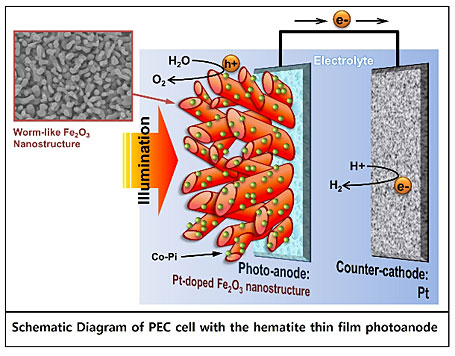
Scientists at Ulsan National Institute of Science and Technology (UNIST), South Korea have created an iron oxide (hematite) photoanode. Since rust never sleeps, this iron oxide photoanode has broken the record in efficiency for solar-hydrogen production at 5.3 percent. The previous record was set by some Swiss scientists at 4.2 percent efficiency.
According to UNIST, “Solar water splitting is a renewable and sustainable energy production method because it can utilize sunlight, the most abundant energy source on earth, and water, the most abundant natural resource on earth. At the moment, low solar-to-hydrogen conversion efficiency is the most serious hurdle to overcome in the commercialization of this technology.
“The key to the solar water splitting technology is the semiconductor photocatalysts that absorb sunlight and split water to hydrogen and oxygen using the absorbed solar energy. Hematite, an iron oxide (the rust of iron, Fe2O3) absorbs an ample amount of sunlight. It has also excellent stability in water, a low price, and environmentally benign characteristics …
“…Prof. Lee and coworkers employed a series of modifications to improve the property of hematite. First, a unique single-crystalline ‘wormlike’ morphology was produced by using a nanomaterial synthesis technique. Second, a small amount of platinum was introduced into the hematite lattice as doping. Finally, a cobalt catalyst was employed to help oxygen evolution reaction. These modifications reduced energy loss due to charge recombination and brought the record-breaking solar-to-hydrogen conversion efficiency.”
The UNIST researchers hope one day to make it to the 10-percent efficiency mark. For right now, however, they are happy to have broken the 5-percent psychological barrier that has bothered scientists for years.
Comments are closed here.